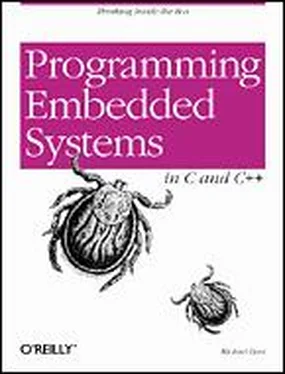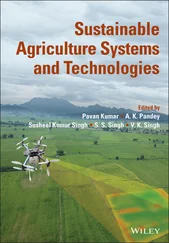The third real-time characteristic of an operating system is the amount of time required to perform a context switch. this is important because it represents overhead across your entire system. For example, imagine that the average execution time of any task before it blocks is 100 µs but that the context switch time is also 100 µs. In that case, fully one-half of the processor's time is spent within the context switch routine! Again, there is no magic number and the actual times are usually processor-specific because they are dependent on the number of registers that must be saved and where. Be sure to get these numbers from any operating system vendor you are thinking of using. That way, there won't be any last-minute surprises.
Despite my earlier statement about how easy it is to write your own operating system, I still strongly recommend buying one if you can afford to. Let me say that again: I highly recommend buying a commercial operating system, rather than writing your own. I know of several good operating systems that can be obtained for just a few thousand dollars. Considering the cost of engineering time these days, that's a bargain by almost any measure. In fact, a wide variety of operating systems are available to suit most projects and pocketbooks. In this section we will discuss the process of selecting the commercial operating system that best fits the needs of your project.
Commercial operating systems form a continuum of functionality, performance, and price. Those at the lower end of the spectrum offer only a basic scheduler and a few other system calls. These operating systems are usually inexpensive, come with source code that you can modify, and do not require payment of royalties. Accelerated Technology's Nucleus and Kadak's AMX both fall into this category, [22] Please don't write to complain. I'm not maligning either of these operating systems. In fact, from what I know of both, I would highly recommend them as high-quality, low-cost commercial solutions.
as do any of the embedded versions of DOS.
Operating systems at the other end of the spectrum typically include a lot of useful functionality beyond just the scheduler. They might also make stronger (or better) guarantees about real-time performance. These operating systems can be quite expensive, though, with startup costs ranging from $10,000 to $50,000 and royalties due on every copy shipped in ROM. However, this price often includes free technical support and training and a set of integrated development tools. Examples are Wind River Systems' VxWorks, Integrated Systems' pSOS, and Microtec's VRTX. These are three of the most popular real-time operating systems on the market.
Between these two extremes are the operating systems that have a bit more functionality than just the basic scheduler and make some reasonable guarantees about their real-time performance. While the up-front costs and royalties are reasonable, these operating systems usually do not include source code, and technical support might cost extra. This is the category for most of the commercial operating systems not mentioned earlier.
With such a wide variety of operating systems and features to choose from, it can be difficult to decide which is the best for your project. Try putting your processor, real-time performance, and budgetary requirements first. These are criteria that you cannot change, so you can use them to narrow the possible choices to a dozen or fewer products. Then contact all of the vendors of the remaining operating systems for more detailed technical information.
At this point, many people make their decision based on compatibility with existing cross-compilers, debuggers, and other development tools. But it's really up to you to decide what additional features are most important for your project. No matter what you decide to buy, the basic kernel will be about the same as the one described in this chapter. The differences will most likely be measured in processors supported, minimum and maximum memory requirements, availability of add-on software modules (networking protocol stacks, device drivers, and Flash filesystems are common examples), and compatibility with third-party development tools.
Remember that the best reason to choose a commercial operating system is the advantage of using something that is better tested and, therefore, more reliable than a kernel you have developed internally (or obtained for free out of a book). So one of the most important things you should be looking for from your OS vendor is experience. And if your system demands real-time performance, you will definitely want to go with an operating system that has been used successfully in lots of real-time systems. For example, find out which operating system NASA used for its most recent mission. I'd be willing to bet it's a good one.
Chapter 9. Putting It All Together
A sufficiently high level of technology is indistinguishable from magic.
Arthur C. Clarke
In this chapter, I'll attempt to bring all of the elements we've discussed so far together into a complete embedded application. I don't have much new material to add to the discussion at this point, so the body of the chapter is mainly a description of the code presented herein. My goal is to describe the structure of this application and its source code in such a way that there is no magic remaining for you. You should leave this chapter with a complete understanding of the example program and the ability to develop useful embedded applications of your own.
The application we're going to discuss is not much more complicated than the "Hello, World!" example found in most other programming books. It is a testament to the complexity of embedded software development that this example comes near the end of this book, rather than at its beginning. We've had to gradually build our way up to the computing platform that most books, and even high-level language compilers, take for granted.
Once you're able to write the "Hello, World!" program, your embedded platform starts to look a lot like any other programming environment. The hardest parts of the embedded software development process-familiarizing yourself with the hardware, establishing a software development process for it, and interfacing to the individual hardware devices — are behind you. You are finally able to focus your efforts on the algorithms and user interfaces that are specific to the product you're developing. In many cases, these higher-level aspects of the program can be developed on another computer platform, in parallel with the lower-level embedded software development we've been discussing, and merely ported to the embedded system once both are complete.
Figure 9-1 contains a high-level representation of the "Hello, World!" application. This application includes three device drivers, the ADEOS operating system, and two ADEOS tasks. The first task toggles the Arcom board's red LED at a rate of 10 Hz. The second prints the string "Hello, World!" at 10 second intervals to a host computer or dumb terminal connected to one of the board's serial ports.
Figure 9-1. The "Hello, World!" application
In addition to the two tasks, there are three device drivers shown in the figure. These control the Arcom board's LEDs, timers, and serial ports, respectively. Although it is customary to draw device drivers below the operating system, I chose to place these three on the same level as the operating system to emphasize that they actually depend more on ADEOS than it does on them. In fact, the embedded operating system doesn't even know (or care) that these drivers are present in the system. This is a common feature of the device drivers and other hardware-specific software in an embedded system.
Читать дальше












